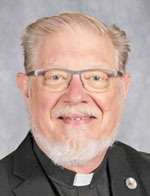That All May Be One / Fr. Rick Ginther
Prayerful rituals are meant to be sensitive to others’ spiritual journey
 Ecumenical and interreligious sensitivity is a part of Church life and teaching.
Ecumenical and interreligious sensitivity is a part of Church life and teaching.
“Lex ordandi, lex credendi”—the law of prayer is the law of belief—is an essential principle in the relationship between what we pray (the words) and what is our faith (teaching).
The “sensitivity” and this “principle” are very much related in our rituals—the statements, prayers and gestures point to the “truth/belief” in the rituals.
A prime example of this is found in the rituals of the Rite of Christian Initiation of Adults (RCIA), especially during Lent.
RCIA is primarily for those who are not baptized and/or have little or no connection to Christianity (called catechumens). The RCIA process leads to the Easter sacraments of baptism, confirmation and the Eucharist.
Secondarily, an adaptation to RCIA was created for those who are already baptized with water (sprinkling, pouring, immersion, submersion) with a pronouncement including the Trinity (Father, Son and Spirit) during the baptizing.
The Catholic Church considers these baptisms to be valid, and some validly baptized Christians seek to become Catholics.
How do we show sensitivity to their prior faith journey? How do RCIA rituals acknowledge their baptismal status?
First, these folks are never referred to as “converts.” They are already Christians. We call them “candidates.” We also use this name for Catholic children and youths preparing for their first holy Eucharist and for confirmation seekers.
Second, when there are combined rites at any point of the RCIA process, the catechumens (elect) are acted upon first, the candidates second.
These “combined rites” of RCIA for catechumens and candidates make a clear distinction in the words spoken over each of them. The ritual actions and spiritual effects themselves are distinct.
For example, the combined Rite of Enrollment (usually in the fall) places the sign of the cross on the catechumens’ forehead, ears, eyes, lips, shoulders, heart, hands and feet, concluding with “sign of eternal life.” The placing on the entire body (senses) bespeaks hope for a complete openness to Christ.
The same rite places the sign of the cross on candidates’ foreheads “… as a reminder of [their] baptism into Christ’s saving death and resurrection.”
Third, some rituals are only for catechumens, some only for candidates.
For example, catechumens are sent to the Rite of Election. It pronounces them “elect” (chosen) for the Easter sacraments.
Candidates take part in the Call to Continuing Conversion, which acknowledges their baptism and intention to continue toward a profession of faith (becoming Catholic) and reception of confirmation and the Eucharist.
The Penitential Rite (on the Second Sunday of Lent) is for the candidates and offers them a strengthening of purpose, prayer for their perseverance, and freedom from whatever sin may be in their lives.
The three scrutinies (on the Third, Fourth and Fifth Sundays of Lent) are for the catechumens. These rituals “… are meant to uncover then heal all that is weak, defective or sinful in the hearts of the elect; to bring out then strengthen all that is upright, strong and good. For the scrutinies are celebrated in order to deliver the elect from the power of sin and Satan, to protect them against temptation and to give them strength in Christ.”
Our prayerful rituals are meant to be sensitive to the prior spiritual journey and spiritual needs of those upon whom they are conferred. The words name the reality of those over whom they are spoken. Gestures appropriate to the words are used.
Care for those who come to us for Christ and in Christ is essential to being Catholic.
It is the ecumenical thing to do.
(Father Rick Ginther is director of the archdiocesan Office of Ecumenism and Interreligious Affairs. He is also the pastor of Our Lady of Lourdes Parish in Indianapolis.) †
 Ecumenical and interreligious sensitivity is a part of Church life and teaching.
Ecumenical and interreligious sensitivity is a part of Church life and teaching.